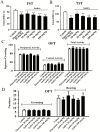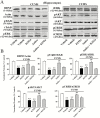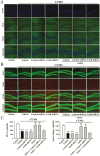Andrographolide Exerts Significant Antidepressant-Like Effects Involving the Hippocampal BDNF System in Mice
- PMID: 31181145
- PMCID: PMC6754737
- DOI: 10.1093/ijnp/pyz032
Andrographolide Exerts Significant Antidepressant-Like Effects Involving the Hippocampal BDNF System in Mice
Abstract
Background: Major depressive disorder is a worldwide neuropsychiatric disorder associated with various symptoms, but current antidepressants used in clinical practice have various side effects and high failure rates. Andrographolide is the main bioactive ingredient of Andrographis paniculata and exhibits numerous pharmacological actions. This study aimed to evaluate the antidepressant-like effects of andrographolide in male C57BL/6J mice.
Methods: The antidepressant-like effects of andrographolide in mice were explored in a forced swim test, tail suspension test, and chronic unpredictable mild stress model of depression. Western blotting and immunofluorescence were further performed to assess the effects of chronic unpredictable mild stress and andrographolide on the brain-derived neurotrophic factor signalling cascade and hippocampal neurogenesis. Moreover, a pharmacological inhibitor (K252a) and a lentiviral-short hairpin RNA (LV-TrkB-shRNA) were used to clarify the antidepressant-like mechanism of andrographolide.
Results: Andrographolide exhibited antidepressant-like potential in the forced swim test and tail suspension test without influencing the locomotor activity of mice. Repeated andrographolide treatment not only produced significant antidepressant-like effects in the chronic unpredictable mild stress model but also prevented the decreasing effects of chronic unpredictable mild stress on hippocampal brain-derived neurotrophic factor signalling and neurogenesis in mice. Importantly, blockade of the hippocampal brain-derived neurotrophic factor system by K252a and TrkB-shRNA fully abolished the antidepressant-like effects of andrographolide in mice.
Conclusions: Andrographolide exerts antidepressant-like effects in mice via promoting the hippocampal brain-derived neurotrophic factor signalling cascade.
Keywords: andrographolide; brain-derived neurotrophic factor; depression; hippocampus.
© The Author(s) 2019. Published by Oxford University Press on behalf of CINP.
Figures










Similar articles
-
Gemfibrozil has antidepressant effects in mice: Involvement of the hippocampal brain-derived neurotrophic factor system.J Psychopharmacol. 2018 Apr;32(4):469-481. doi: 10.1177/0269881118762072. Epub 2018 Mar 14. J Psychopharmacol. 2018. PMID: 29534628
-
Antidepressant-like effects of tetrahydroxystilbene glucoside in mice: Involvement of BDNF signaling cascade in the hippocampus.CNS Neurosci Ther. 2017 Jul;23(7):627-636. doi: 10.1111/cns.12708. Epub 2017 May 25. CNS Neurosci Ther. 2017. PMID: 28547794 Free PMC article.
-
The antidepressant-like effects of the water extract of Panax ginseng and Polygala tenuifolia are mediated via the BDNF-TrkB signaling pathway and neurogenesis in the hippocampus.J Ethnopharmacol. 2021 Mar 1;267:113625. doi: 10.1016/j.jep.2020.113625. Epub 2020 Nov 25. J Ethnopharmacol. 2021. PMID: 33248184
-
Behavioral and serotonergic consequences of decreasing or increasing hippocampus brain-derived neurotrophic factor protein levels in mice.Neuropharmacology. 2008 Nov;55(6):1006-14. doi: 10.1016/j.neuropharm.2008.08.001. Epub 2008 Aug 12. Neuropharmacology. 2008. PMID: 18761360 Review.
-
The hippocampus, neurotrophic factors and depression: possible implications for the pharmacotherapy of depression.CNS Drugs. 2011 Nov 1;25(11):913-31. doi: 10.2165/11595900-000000000-00000. CNS Drugs. 2011. PMID: 22054117 Review.
Cited by
-
The Antidepressant-Like Effects of Shen Yuan in a Chronic Unpredictable Mild Stress Rat Model.Front Psychiatry. 2021 Jan 28;12:622204. doi: 10.3389/fpsyt.2021.622204. eCollection 2021. Front Psychiatry. 2021. PMID: 33584387 Free PMC article.
-
Neurobiological Promises of the Bitter Diterpene Lactone Andrographolide.Oxid Med Cell Longev. 2022 Feb 1;2022:3079577. doi: 10.1155/2022/3079577. eCollection 2022. Oxid Med Cell Longev. 2022. PMID: 35154564 Free PMC article. Review.
-
Protective effects of andrographolide against cerebral ischemia‑reperfusion injury in mice.Int J Mol Med. 2021 Oct;48(4):186. doi: 10.3892/ijmm.2021.5019. Epub 2021 Aug 9. Int J Mol Med. 2021. PMID: 34368862 Free PMC article.
-
Oral andrographolide loaded lipid nanocarriers alleviate stress behaviors and hippocampal damage in TNF alpha induced neuroinflammatory mice.Sci Rep. 2025 Apr 8;15(1):11939. doi: 10.1038/s41598-025-96758-1. Sci Rep. 2025. PMID: 40200039 Free PMC article.
-
The Role of Adaptogens in Prophylaxis and Treatment of Viral Respiratory Infections.Pharmaceuticals (Basel). 2020 Sep 8;13(9):236. doi: 10.3390/ph13090236. Pharmaceuticals (Basel). 2020. PMID: 32911682 Free PMC article. Review.
References
-
- Adlam J, Zaman R (2013) The role of BDNF and memory in major depressive disorder. Psychiatr Danub 25:S368–S369. - PubMed
-
- Bera R, Ahmed SK, Sarkar L, Sen T, Karmakar S (2014) Pharmacokinetic analysis and tissue distribution of andrographolide in rat by a validated LC-MS/MS method. Pharm Biol 52:321–329. - PubMed
-
- Bertoglio JC, Baumgartner M, Palma R, Ciampi E, Carcamo C, Cáceres DD, Acosta-Jamett G, Hancke JL, Burgos RA (2016) Andrographis paniculata decreases fatigue in patients with relapsing-remitting multiple sclerosis: a 12-month double-blind placebo-controlled pilot study. BMC Neurol 16:77. - PMC - PubMed
-
- Blendy JA. (2006) The role of CREB in depression and antidepressant treatment. Biol Psychiatry 59:1144–1150. - PubMed
-
- Bothiraja C, Pawar AP, Shende VS, Joshi PP (2012) Acute and subacute toxicity study of andrographolide bioactive in rodents: evidence for the medicinal use as an alternative medicine. Comp Clin Pathol 22:1123–1128.
Publication types
MeSH terms
Substances
LinkOut - more resources
Full Text Sources
Medical

